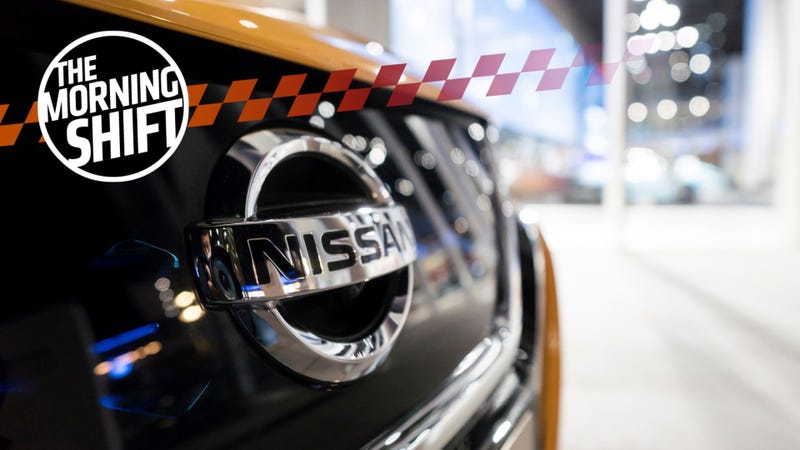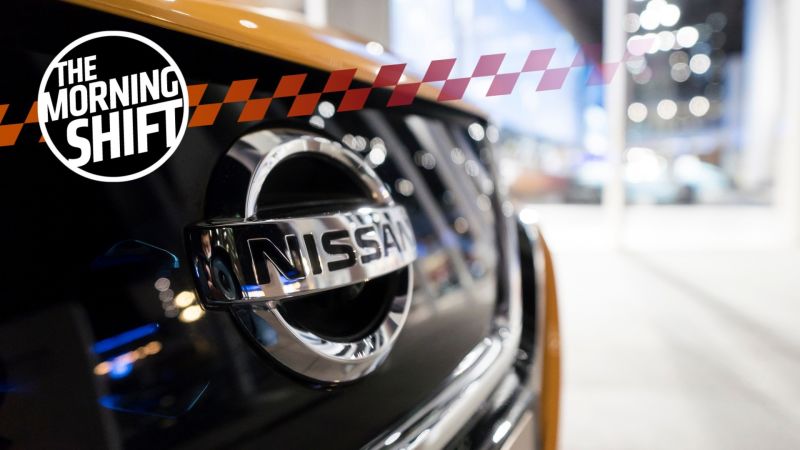
 The Morning ShiftAll your daily car news in one convenient place. Isn’t your time more important?
The Morning ShiftAll your daily car news in one convenient place. Isn’t your time more important? Nissan slashes sales targets in China, BMW is introducing a savings plan to account for a projected downturn in sales and President Donald Trump is playing out his reelection campaign amid the General Motors-UAW fight in Ohio. All this and more in The Morning Shift for Wednesday, March 20, 2019.
1st: Nissan Cuts China Sales Targets Amid Downturn
It’s no secret that Nissan has been having a rough time lately. Between the entire Carlos Ghosn criminal scandal, a lack of new models in the pipeline and a downturn in the auto market overall, the automaker has decided that its best strategy is to reduce target sales in China by eight percent to further insulate itself from disaster.
Remember that auto sales in China—still the world’s biggest car market but long considered a golden goose with no end to the eggs it could make—are way down, and poised to sink further in 2019. That’s bad news for automakers who had grand designs on China, which was basically all of them.
Here’s more from Bloomberg:
Nissan and Dongfeng Motor now forecast that their joint venture will sell 2.39 million vehicles in 2022, the end of the current mid-term plan. That is a reduction of 220,000 units from the previous target, the people said, asking not to be identified because the outlook is not public. Including imports, they sold a total of 1.56 million vehicles in China in 2018, an increase of 3.4 percent.
One key factor is that Nissan is in between models at a time when the market is weak. Passenger vehicle sales in the country fell 6 percent to 22.7 million units last year, the first decline since the early 1990s, while ongoing trade tensions with the U.S. threaten to dampen demand even further. No major new Nissan models are planned for the China market through 2020, and its luxury Infiniti brand plans no new vehicles through 2021, the people said.
“Fresh new models are what keeps traffic coming to the showroom,” said Bill Russo, chief executive officer of Shanghai-based consultancy Automobility. “It’s especially true in hypercompetitive markets like China.”
[…]
Nissan’s mid-term plan calls for an operating profit margin of 8 percent on revenue of 16.5 trillion yen by 2022, with China contributing almost a third of revenue. Ghosn had pledged to invest $9 billion and introduce a slew of new electric vehicles, as Nissan vies with global rivals including Volkswagen Group and General Motors to become the largest electrified vehicle maker in the country.
Advertisement
This is just one look at what the future could hold for other automakers with a stake in the Chinese market as it continues its downturn.
2nd: BMW Introduces Savings Plan Ahead of Profit Falls
BMW is expecting to lose up to ten percent of their pretax profits in 2019, Reuters reports. That’s encouraging the automaker to introduce a comprehensive $13.6 billion saving plan “to help offset higher technology investment and currency costs.” In other words, it’s expensive to invest in electric vehicles, and Brexit and a tariff threat in the U.S. aren’t helping.
Advertisement
Here’s more from the Reuters article:
“The high level of volatility makes it difficult to provide a clear forecast,” BMW said. “Depending on how conditions develop, our guidance may be subject to additional risks; in particular, the risk of a no-deal Brexit and ongoing developments in international trade policy,” Chief Financial Officer Nicolas Peter said.
BMW said it would expand group-wide efforts to increase efficiency and lower costs.
“By the end of 2022, it expects to leverage potential efficiencies totaling more than 12 billion euros,” BMW said in a statement.
Some of that would come from ramping up digital simulations as a way to reduce development times of new vehicle models by as much as a third.
Advertisement
Operating profit last year fell 7.9 percent. This year, they believe, will be even more difficult with the high cost of developing electric and self-driving cars taking a toll on profits.
If BMW needs any help deciding which models to cut as its slashes costs, we have some suggestions.
3rd: Ohio Is Trump’s Proving Ground
Is anyone surprised that Trump’s tweets have caused more problems than they’ve solved at this point? Over the weekend the president ordered both GM CEO Mary Barra and the UAW to get something, anything happening on the Lordstown, Ohio plant that was “unallocated” this month as its sole model, the slow-selling Chevrolet Cruze, is getting discontinued.
Advertisement
Ohio is a crucial area for Trump as he seeks reelection next year, and he’s admitted as much. He handily won the state in 2016, but if he can’t deliver on promises to bring back manufacturing jobs, it could hurt him the next go-around.
But the tweets may just make the current GM-UAW showdown worse, according to Bloomberg:
Trump can’t take Ohio for granted in his bid for re-election next year. His fortunes may ride on manufacturing jobs, the effect of his trade war with China and the overall state of the economy. Some polling indicates his approval in Ohio has slipped, and Democrats are circling the state, hoping to move it back into their column.
[…] Meanwhile, Trump’s Twitter barrage is unlikely to re-open the idled plant. But his intervention in the matter will intensify what are already shaping up to be hard-fought negotiations between GM and the United Auto Workers union. GM and the UAW have each pushed back on Trump’s tweets, but the two have otherwise been very much at odds entering bargaining over a new four-year labor contract.
“Trump’s tweets definitely amped it up,” said Jeff Schuster, senior vice president of researcher LMC Automotive. “It adds layers of pressure on GM.”
Advertisement
Meanwhile, Trump will be paying a visit to a thriving M1 Abrams tank factory in Lima, Ohio today, which serves as a symbol of Trump’s increases to the defense budget. It’s a move designed to turn attention away from the president’s struggle to bring back automotive jobs, particularly ones from U.S. automakers:
“The tank plant’s doing well, so he’s going there despite cutting defense spending elsewhere to pay for his national emergency,” said Jennifer Duffy of the Cook Political Report, referring to Trump’s plan to pay for a wall along the southern U.S. border by reallocating some military funding.
“But on the other hand, Lordstown symbolizes nothing but a broken campaign promise,” Duffy added. “He was going to keep this plant open, he was going to create more jobs there.”
Advertisement
The auto industry has become a viable proving ground for potential 2020 presidential candidates to display their economic policies. So, get excited for that!
4th: Why Tesla’s Worker Injuries Have Increased
The strain of Tesla’s burgeoning electric car sales has started to become apparent in the increase of employees who missed work in 2018 due to work-related injuries and illness.
Advertisement
Here’s more from Automotive News Europe:
Staff at Tesla’s lone assembly plant in Fremont, California, logged 22,454 days lost in 2018, up from 7,619 in 2017, according to a report the company submitted to the Occupational Safety and Health Administration. This surge outpaced increases in hours worked, total injuries and number of cases in which injuries caused employees to be absent.
When taking headcount growth into account, the amount of time away per worker doubled last year. The overall rate of injuries per hour of work remained roughly the same as in 2017.
The sharp increase in the number of days away from work suggests a greater severity of injuries, said Deborah Berkowitz, who served as OSHA’s chief of staff under President Barack Obama and called the data “alarming.” The rise in the average time missed — to 66 work days in 2018 from 35 the year before — is a “red flag,” she said.
Tesla disputes this conclusion, saying there’s no correlation between the number of days employees are out of work and the severity of injuries. The report shows the company managed to boost production while keeping the number of injuries roughly in proportion with the rise in total hours worked, Laurie Shelby, Tesla’s vice president for environmental health and safety, said in a phone interview. There were no fatalities at the factory either year.
[…]
Two-thirds of the injuries last year were cumulative trauma, Shelby said. These are ailments related to repetitive stress on areas of the body including the neck, shoulders, back, wrists and hands.
Advertisement
According to Shelby, Tesla’s motto is “the most important metric is fatalities, and our number is zero.” That’s all well and good, but tell it to workers who have been maimed in car plants.
5th: Vietnamese Hackers Target Auto Industry
If you were asked about the state of Vietnam’s automotive industry, chances are, you wouldn’t have any idea where to begin. But “state-aligned” hackers have been attacking foreign automotive companies in an effort to protect the country’s industry, as per a report by cyber-security provider FireEye.
Advertisement
Bloomberg has more:
FireEye, which… dates its activities to 2014, said the attacks accelerated in early February. The hacking targeted companies in Southeast Asia and “the broader areas surrounding Vietnam,” said Nick Carr, a FireEye senior manager.
“Beginning in February, we see this large uptick based on our product and services visibility showing us a lot of activity targeting the automotive industry,” Carr said. “It is likely to support the Vietnamese government’s publicly stated domestic manufacturing goals for automobiles.”
Vietnam’s Ministry of Foreign Affairs didn’t immediately respond to an emailed request for comment. After FireEye published a report detailing the Vietnamese-linked group’s activities in 2017, Ministry of Foreign Affairs spokeswoman Le Thi Thu Hang said the government doesn’t allow any form of cyber-attacks against individuals or organizations.
Advertisement
So, what are the hackers trying to actually do? Carr has reasoned that, rather than looking for the acquisition of property, the hackers are trying to gain an advantage in the auto industry by seeking out corporate operation information—all those documents that aren’t available to the public and detail the operations of the company<CQ. It’s a way to uncover other companies’ weaknesses and to get a leg up on the competition.
Reverse: James Packard dies in 1928
James Packard didn’t live long enough to see his cars become the vehicle of choice for luxurious 1930s-era film stars. Serving as both company president and chairman of the board, Packard watched his initial investment of a few thousand dollars transform into a multi-million dollar company.
Advertisement
Neutral: Who Survives The Massive EV Investment Costs?
Developing EVs and autonomous tech are all the rage right now—but that kind of comprehensive change across an entire industry is tough to pull off and can be hell on a manufacturing budget. Volkswagen alone is putting $91 billion into the effort, and you can bet not everyone has that kind of cash.
Is this push for development going to pay off, or are we going to see the downfall of a lot of beloved marques?













